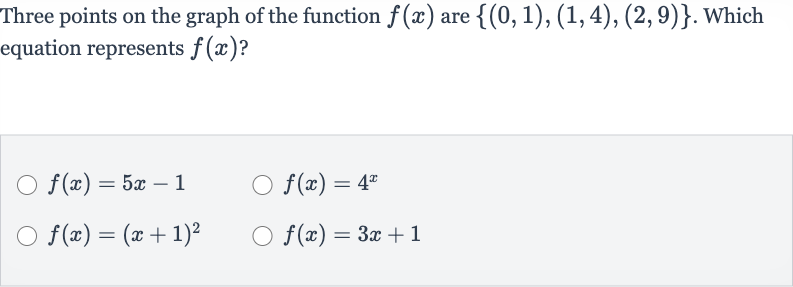Full solution
Q. Three points on the graph of the function are . Which equation represents ?
- Test Equation : Test the first equation with the given points.Substitute into to see if it gives .Check if this matches the given point .
- Check : Since does not match the given point , we can conclude that is not the correct equation.
- Test Equation : Test the second equation with the given points.Substitute into to see if it gives .Check if this matches the given point .
- Check : Since matches the given point , we proceed to test the next point . Substitute into to see if it gives . Check if this matches the given point .
- Test Equation : Since matches the given point , we proceed to test the last point .Substitute into to see if it gives .Check if this matches the given point .
- Check : Since does not match the given point , we can conclude that is not the correct equation.
- Check : Since does not match the given point , we can conclude that is not the correct equation.Test the third equation with the given points.Substitute into to see if it gives .Check if this matches the given point .
- Check : Since does not match the given point , we can conclude that is not the correct equation.Test the third equation with the given points.Substitute into to see if it gives .Check if this matches the given point .Since matches the given point , we proceed to test the next point .Substitute into to see if it gives .Check if this matches the given point .
- Check : Since does not match the given point , we can conclude that is not the correct equation.Test the third equation with the given points.Substitute into to see if it gives .Check if this matches the given point .Since matches the given point , we proceed to test the next point .Substitute into to see if it gives .Check if this matches the given point .Since matches the given point , we proceed to test the last point .Substitute into to see if it gives .Check if this matches the given point .
- Check : Since does not match the given point , we can conclude that is not the correct equation.Test the third equation with the given points.Substitute into to see if it gives .Check if this matches the given point .Since matches the given point , we proceed to test the next point .Substitute into to see if it gives .Check if this matches the given point .Since matches the given point , we proceed to test the last point .Substitute into to see if it gives .Check if this matches the given point .Since matches the given point , we can conclude that is the correct equation that represents .
More problems from Write a quadratic function from its x-intercepts and another point
QuestionGet tutor help
QuestionGet tutor help
QuestionGet tutor help
QuestionGet tutor help
QuestionGet tutor help
QuestionGet tutor help
QuestionGet tutor help
QuestionGet tutor help

